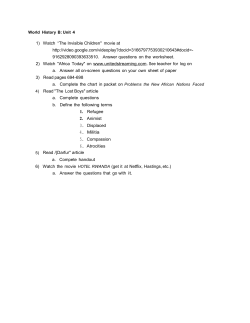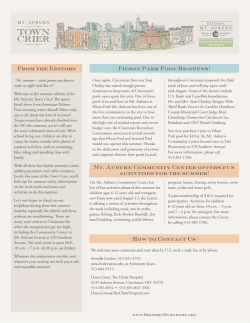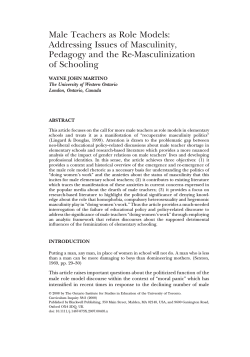
Apparel Product Development for Plus-sized Tween and Teen Boys Year One Research
NTC Project: SO6-AC03 1 Apparel Product Development for Plus-sized Tween and Teen Boys Lenda Jo Connell, Pamela Ulrich, co-leaders; Karla Simmons,David Pascoe (Auburn) ,David Bruner [TC]² Tween boys are a viable market commanding a significant market presence, but there is little research in the public domain to support apparel product development for them. According to The U.S. Tween Market, a new research report published by Packaged Facts and available through MarketResearch.com, the spending power of this cohort totals about $40 billion. Another report estimates that the 15 million tween boys in the United States currently spend $20 billion a year. Statistics indicate a large number of boys in this age range fall outside the normal size category and that they constitute a growing niche market. NPD reported that the kid’s plus-size apparel industry has grown to be about $3 billion a year or about 12 percent of the overall children’s clothing market (Thirteen Hot Businesses for 2005, 2004). This study defines tween boys as between the ages of 9-14 and focuses on defining sizing and clothing preferences across the range of the market. Objectives for the research are as follows: ● physical and psychological characteristics of young boys aged 9-14 ● market potential for developing apparel products for this niche market ● and sizing categories based the range of sizes discovered from 3D body scans. It extends and enlarges the range of the current NTC research project, S04-AC01, exploring product development and sizing issues for tween and teen girls. Year One Research During the first year of this project a series of eight focus groups were completed as follows: ● 9-11 Normal Size Boys and Mothers ● 9-11 Plus-size Boys and Mothers ● 12-14 Normal Size Boys and Mothers ● 12-14 Plus-size Boys and Mothers Mothers and boys were interviewed in separate focus groups with each group having 8-12 participants with a total of 44 boys across all groups. Focus groups were completed in December, 2006. Size groupings for the boys were determined by Body Mass Index (BMI) guidelines for boys approved by the U.S. Center for Disease Control. Boys were defined as overweight or at risk of being overweight when their BMI scores reached the level of at least the 85th percentile in their age category. Before the focus groups began, boys and their mothers were body scanned using a [TC]² NX 12 Body Scanner. Both mother and son completed a questionnaire probing body image and attractiveness issues, feelings about clothing, and apparel selection experiences. From a set of drawings, boys were asked to identify their current body image and their ideal body image. Mothers were also asked to identify the size closest to their son’s body and the ideal body for that age (i.e. tween or adult). Results Research by Pisut (2002), Alexander (2003) and Simmons, Istook, and Devarajan (2004) used body scan data to explore the adult female body shape. Results showed a distribution of varying body shapes including hourglass, rectangular, and pearshaped figures could be found in the adult National Textile Center Annual Report: June 2007 NTC Project: SO6-AC03 2 female population. A current NTC project investigating young female tweens/teens indicates a wide range of body measurements and shapes exist within this apparel category (Connell & Ulrich, 2005). However, young males have not been studied in a similar manner to understand body shape and the breadth of body measurements across the age category. Body scans suggest a wide range of body sizes and shapes exist among boys ages 914. Figure 1 shows the 3D body scans of 21 boys, 9-11years old with body sizes ranging form normal to plus-size. Boys 9-11 Normal/Plus-sized olds. The older boys’ mean BMI was lower, 27.53, compared to 95th percentile BMIs of 24.2-26 for 12-14 year-olds. Our study also explores the social and psychological implications of body size and shape for boys. Previous research found that boys chose ideal figures that were moderately but significantly heavier than their perceptions of their own bodies, supporting the idea that boys maturing through puberty see increasing body mass as desirable. This was true for three of our groups. However, initial analysis of data from boy’s responses to the questionnaire used in the focus groups, indicates that when plus-sized older boys rated their current body size and their ideal body size on a 7point scale, on average, their average self ratings were higher than their average ideal ratings Younger Normal —9-11 OLDER, PLUS-SIZED BOYS AVERAGE SELF AVERAGE IDEAL Younger Plus-sized—9-11 Figure 1: Scans of 9-11 Tween Boys in Normal and Plus-sized BMI Range Younger boys’ mean BMI was 16.58, compared to 50th percentile BMIs of 16.217.2 for 9-11 year-olds. The mean for older boys’, 19, compared to 50th percentile BMIs of 17.8-19.2 for 12-14 year-olds. The mean BMI scores for the two husky size groups were above the CDC’s 95th percentile definition of overweight. The younger boys’ mean BMI was 29.53, compared to 95th percentile BMIs of 21.2-23.2 for 9-11 year- Focus groups are being transcribed for content analysis. Questionnaire responses are being analyzed to understand apparel preferences, shopping habits, and feelings about having appropriate clothing. Contributors: Graduate Students: Katie Brock, Yukti Sancheti, Melissa Manuel, Holly Skinner, Brooke Huddleston, Sarah Helm, Angelina Calabro Industry Interactions; Fit Logic Technologies, [TC]², Jockey, Dillard’s, VF Corp. Project website: http://www.ntcresearch.org/projectapp/?project=S06-AC03 National Textile Center Annual Report: June 2007 NTC Project: SO6-AC03 3 Lenda Jo Connell, a Professor in Consumer Affairs at Auburn, joined the faculty in 1971 after receiving a masters degree in clothing and textiles from Louisiana State Univ. In 1990, she earned a Ed.D. in adult education from Auburn. For 15 years she was an Extension Resource Management Specialist for the textile and apparel industry and now coordinates the Apparel Production Management program. Her research interests Include body shape analysis and apparel preference testing. I92-A05*, I92-A06, I94A10T*, I94-A13, I95-A19*, I95-A20, I98-A7, I98-A08*, I98-A09, S01-AC27*, S04-AC01* connelj@auburn.edu (334)-3789 http://www.humsci.auburn.edu/publish.php?id=84&facultyId =61 Pamela V. Ulrich, an Associate Professor in Consumer Affairs at Auburn, joined the faculty in 1987. Pam earned a Ph.D. in American history from Univ. of Oregon in 1991 and a M.S. in clothing and textiles from Auburn in 1980. Her work experience includes department store retailing. At Auburn, she manages the Historic Costume and Textile Collection. Her research interests include apparel fit and shape analysis, product development, and historical change in textiles, apparel and retailing. I92-A06, I92-A07, I95-A19, I95-A20, I98-A7*, I98-A08, I98A09, S01-AC27, S04-AC01* ulricpv@auburn.edu ((334)-8441336 http://www.humsci.auburn.edu/publish.php?id=84&facultyId =72 David A. Bruner, Director of Technology Development at [TC]², joined the staff in 1995. David earned a BS in mechanical engineering from Univ. of Missouri Rolla in 1983 and a Ph.D. in mechanical engineering from Univ. of Kentucky in 1993, specializing in nonlinear finite element analysis. For 12 years David was in development engineering and management at IBM (input devices and notebook computers), Ericsson (cellular telephones) and Brother Int. (ink jet products). His research interests include full body scanning and automatic measurement extraction software. S01-AC27, F02-NS08, S04-AC01 dbruner@tc2.com (919)-380-2171 David Pascoe, an Assistant Professor in Health and Human Performance at Auburn, joined the faculty in 1990 when he received a Ph.D. degree in bioenergetics from Ball State. Earlier he received a M.A. from California StateFresno. Dave's research interests include physiological evaluation of clothing systems for heat and cold stress and thermography to identify hazards due to protective clothing systems. F92-G01, F95-S24, S01-AE32, S04-AC01 pascodd@mail.auburn.edu (334)-844-1473 http://www.auburn.edu/~pascod d Karla Simmons, an Assistant Professor in Consumer Affairs at Auburn, joined the faculty in 2005 from the Univ. of Missouri where she was an Assistant Professor and site coordinator for SizeUSA. Karla earned a B.S. in 1992, an M.S. in 1996 (both from Auburn) and a Ph.D. in textile and apparel technology and management from NC State in 2002, then briefly supervised the Automated Cutting Dept. at Oneita Ind. Her research interests include 3-D body scanning technology, apparel fit and sizing, and product development. S04-AC01 simmokp@auburn.edu (334)-844-1345 http://www.humsci.auburn.edu/publish.php?id=84&facultyId =112 National Textile Center Annual Report: June 2007
© Copyright 2025





















